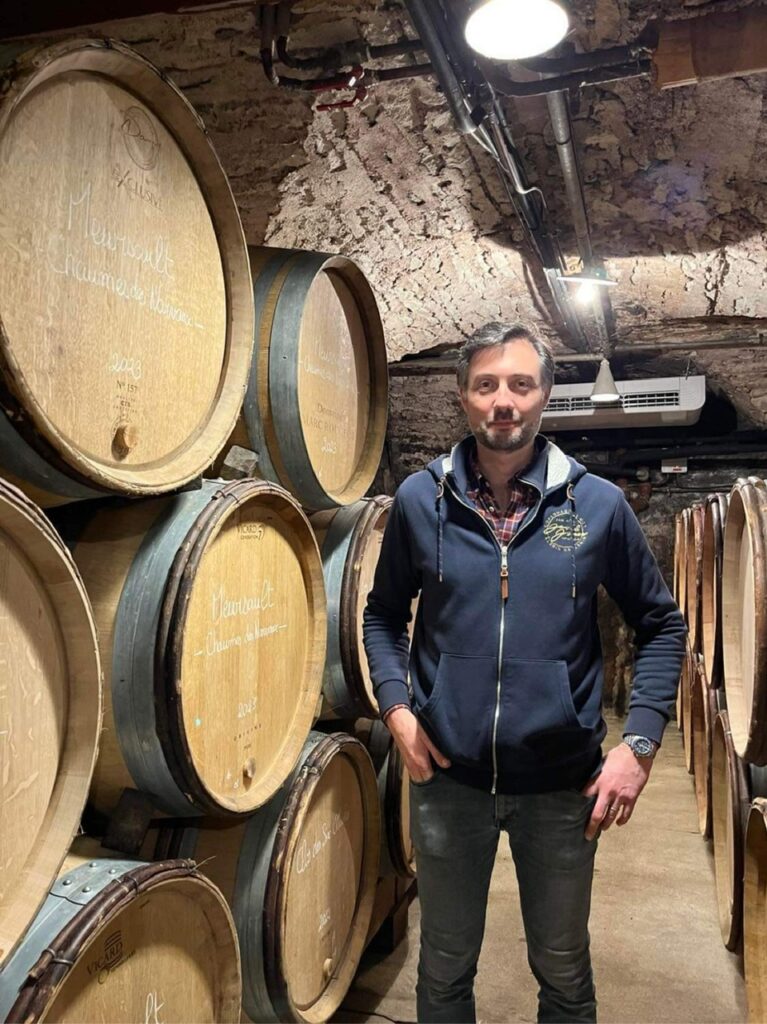Sometimes articles are difficult to construct, and this is one of the worst so far, as I want to synthesize its meat and then clearly explain it, so that the vigneron involved gets the credit he deserves.

The issue is: Can white Burgundy successfully be made and bottled without sulphur, and without using Diam closures?
A precautionary note
Regardless of what people say, one needs to take extra precautions with unsulphured wines. They must be kept cool, and they should not be challenged by temperature variations or excessive transport. In reality this goes for all wines, but especially the unsulphured ones – even with Diam stoppers.
You must ensure that unsulphured wines come from a safe source. In some cases this means wines that are made for drinking in or near Burgundy, as they can be both unsulphured and with natural-cork stoppers.
The taster’s paradox
When one tastes unsulphured wines from barrel, one is very close to the final bottling -the wine that will end up in the shop. In reality, however, bottling does influence the taste, as the wine is lightly compressed into the bottle.
When tasting sulphured wines, the difference between unsulphured barrel and bottle is notable. One needs to correct one’s perception when barrel-tasting a sulphured product to visualise – or tastualise – the finished product.
I try to visualise the final product in every case, although with unsulphured wines this process is different. It requires experience, and focus!
The ‘Hog’s feeling
I am learning to taste and drink unsulphured white Burgundies. This is a process, however, and while I am not yet at the end of my learning curve, I will express my current perceptions of the issue.
My feeling was – and to some degree still is – that chardonnays made and bottled without sulphur often lack an expression of minerality; a mineral edge, or whatever you would like to call it. I am talking about wines with natural-cork stoppers.
And while I speak of the perception of minerality, this also means that unsulphured wines can sometimes lack terroir definition, or the spark of terroir expression. This is complex, but is nonetheless my feeling.
Nothing, however, is black and white, and this perception could be changed by longer elevage times, the level of reduction, and last but not least, the use of Diam stoppers.
As always, in well-made wines, bigger terroirs will manifest themselves regardless, whereas village and 1ers crus might need more emphatic techniques during their production.
Diam, however, changes the world for wine producers, and for bottles without sulphur!
So why the sulphur question
The reason I’m focussing on unsulphured whites is Domaine Rougeot, led by Pierre-Henri Rougeot, one of the leading makers of unsulphured wines.
I really like his sulphur-free reds, and therefore I want to understand his whites as well. I have now fallen for his aligote without sulphur, so what will be next?
To put this in perspective, producers such as Morey-Coffinet have 25-30 milligrams/litre of free sulphur when bottling its whites. Pierre-Yves Colin-Morey uses 30-40 mg/l for his whites, while Vincent Dancer (Theo Dancer) uses 20-25 mg/l. These are all bottled under natural corks.
When we move to Diam stoppers, there are producers who uses no sulphur – Chantereves, for example – while Pierre-Henri Rougeot takes the brave route, going without sulphur while using old-school, high-quality natural corks.
And so, to the Rougeot whites, which were on December 4 last year.
Only wines of interest, and mainly those that are recommended, are included in this tasting report.

Steen Öhman
Chief Tasting OfficerDomaine Rougeot Aligote 2022
The aligote is only made in one version without sulphur – Les Blumes – and it is an expressive and complex wine. As mentioned above, this is better without sulphur than it would be with, and in this example the definition of terroir and fruit flavours are not lacking. It’s elegant and vivid, with nice acidity.
(Drink From 2024) – Very Good – (89p) – ![]()
Domaine Rougeot Monatine 2022
Monatine is the entry-level white – however not a village but a AOC from the bottom of the village, just north of Sous la Velle. Not complex, it’s nonetheless a delightful vin de soif in a good way, without being on the rich side. Its structure suggests earlier drinking; serve it well chilled to get maximum pleasure.
(Drink From 2025) – Very Good – (88p) – ![]()
Domaine Rougeot Grandes Gouttes 2022
Classic below Meursault: open, vivid, delicate, and airy, this has an elegant, effortless feeling. That said, it does not overwhelm with complexity.
(Drink From 2028) – Very Good – (90p)
Domaine Rougeot Saint Romain 2022
The 2022 is perhaps not the obvious choise for Saint Romain, but the 90-year-old vines somehow manage to provide a good, acidic, ass-kick. This is elegant, slightly reduced, and stomach-fillingly rich. A unique wine, to be served with grilled lobster, please.
(Drink From 2030) – Very Good – (89p) – ![]()
Domaine Rougeot Meursault Sous la Velle 2022
While Sous la Velle is a terroir down the slope in Meursault, it still has vivid freshness and surprising complexity. I am often surprised by the hedonistic pleasure I get from the wines from this lieu-dit. Points and ratings are not the world to me, and this is a hedonistic delight.
(Drink From 2030) – Very Good – (90p) – ![]()
Domaine Rougeot Meursault Limozin 2022
Meursault Limozin is a lovely, vivid wine; the Limozin terroir often produces lively acidity and a gourmand palate. This is quite robust, yet at the same time delicate and effortless. This terroir is too rarely seen from good producers, and sadly, this is the last vintage of it from Domaine Rougeot.
(Drink From 2028) – Very Good – (90-91p) – ![]()
You need to login as a Premium subscriber to read the rest of this article. If you are not a Premium Subscriber, use the subscribe function and sign-up.

 - A true vin d’émotion – a Burgundy of passion
- A true vin d’émotion – a Burgundy of passion - A truly hedonistic wine – lively and enjoyable
- A truly hedonistic wine – lively and enjoyable - A vivacious wine for pure indulgance
- A vivacious wine for pure indulgance - A potential vin d´émotion - frais et léger
- A potential vin d´émotion - frais et léger